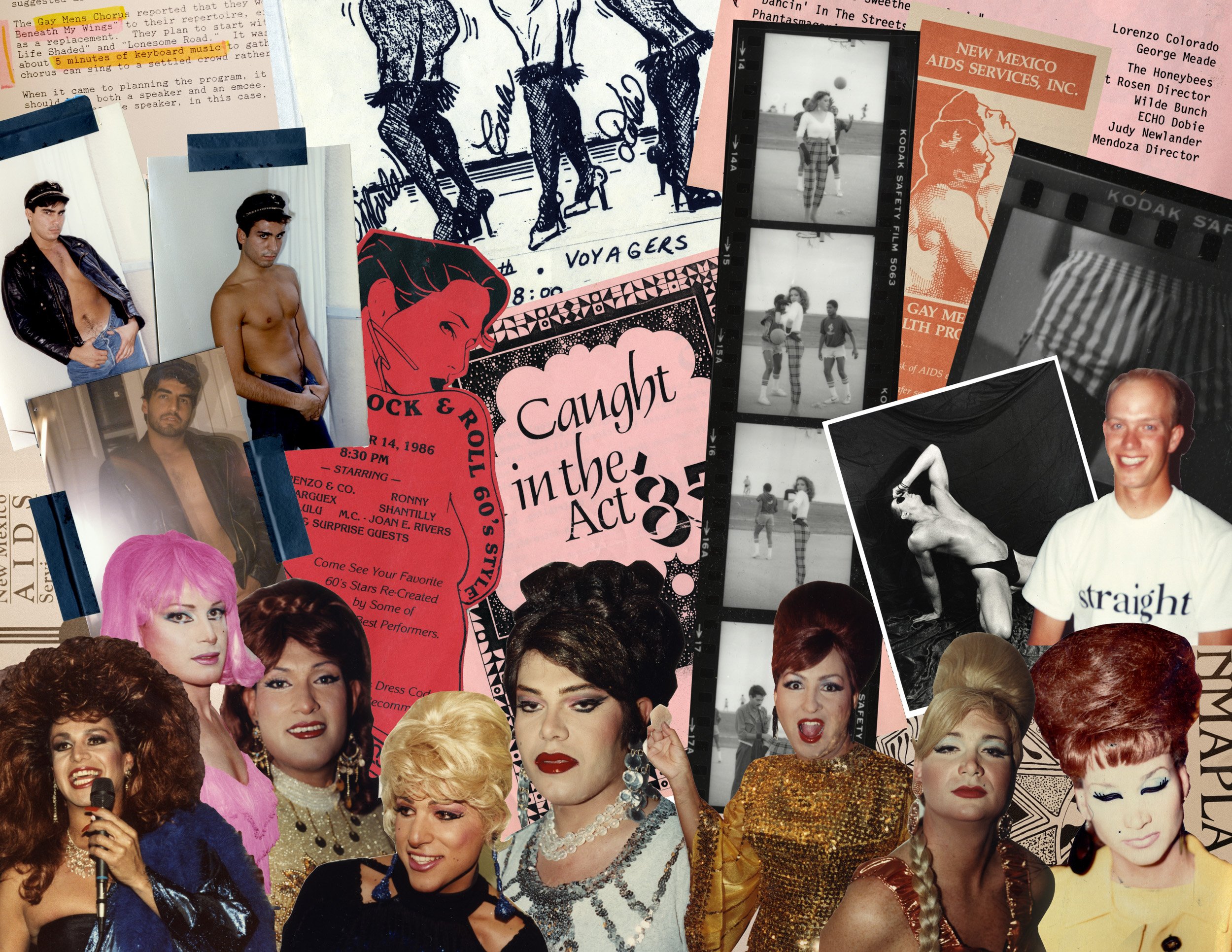
Tracing ChicanX
Queer Histories
Tracing Queer ChicanX Histories Vol. 1
by Apolo Gomez
THANK YOU
David Evans Frantz
Mike “Skye” Moreno
Roland Palencia
Loni Shibuyama and the staff at
One Archives, USC, LA. CA.
The Honeybee’s
Kenny Chavez, Ronnie Chavez, Larry Roybal, Manuel Sena, and Larry Trujillo
ABQ Tea Dance
Justin Cristofer, Brian Fejer, and Steven J Westman
To everyone in the Los Angeles and Albuquerque communities who have come before us and those who will continue to carry our history.
Tracing Queer ChicanX Histories Vol. 1 is supported by the Fulcrum Fund, grant program of 516 ARTS made possible by The Andy Warhol Foundation for the Visual Arts and the Meow Wolf Fouuundation.
In the pursuit of uncovering the often overlooked histories of queer Chicanx communities, I embarked on a journey from Albuquerque to Los Angeles, two cities rich with histories of community, art, and activism. As someone who was raised in Southern California and grew up in New Mexico, I have a strong connection to both communities. This project is not just about research; it is about connection, both to the past and to those in our community who continue to carry these histories forward.
My journey began by revisiting the exhibition “Axis Mundo: Queer Networks in Chicano L.A.”, MOCA, L.A., 2017. An exhibition curated by C. Ondine Chavoya and David Evans Frantz, that looked back into the networks of queer Chicanx artists in L.A. from the late 1960s to the early 1990s. Encouraged by this exhibition to not only look back at my own history but that of my community, I visited USC One Archives in L.A., the largest repository of LGBTQ+ materials in the world. Within its walls, I sifted through photographs, newsletters, and ephemera that told the stories of Chicanx queer organizers, artists, and activists who fought for visibility and liberation.
Among the most influential figures I encountered was Roland Palencia, a pioneer in LGBTQ activism, who’s archives are housed at USC One Archives. In the 1980s, Roland founded numerous queer Latinx organizations, including Gay and Lesbian Latinos Unidos and VIVA!, the latter of which became a pivotal arts organization. His leadership extended into healthcare and community organizing, as seen in his roles at L.A. Care Health Plan, The California Endowment, and the AIDS Healthcare Foundation. Through these positions, Roland has continuously championed marginalized communities and he continues to uplift LGBTQ narratives. Roland’s insights provided a critical understanding of the social and political landscapes that shaped these movements and the lasting impact of spaces like VIVA! in fostering artistic expression and activism in the 1980s and ‘90s.
A crucial figure in this history and former member of ASCO and VIVA! is Robert “” Legorreta, the Chicano performance artist, activist, and cultural provocateur whose work has challenged conventional narratives around race, sexuality, and gender since the 1960s. Cyclona’s legacy has been explored by many scholars and artists, including Bernadine Hernández, who conducted an in-depth interview that provides a rare and invaluable insight into their life and work. This interview sheds light on the intersections of Chicanx identity, queerness, and radical performance art, grounding Cyclona’s influence in queer Latinx history. Robert’s collaborations with artists like Mike Morena continue to inform and inspire a new generation of creators who push against societal constraints in their work.
Back in Albuquerque, I explored similar narratives in the Southwest. It was here that I connected with Mike Moreno, an artist whose work serves as a bridge between cultural heritage and queer identity. Through mixed media, Mike delves into social issues, sexuality, spirituality, and living with HIV/AIDS. Mike’s impact extends beyond his artwork. As a co-founder of VIVA! in 1987, he helped create a platform for Latino/a LGBTQIA artists, fostering a community that has influenced countless individuals. Mike collaborated with Robert Legorreta to create the now iconic “The Third Eye of Cyclona” head piece worn by Cyclona. Mike’s dedication to community organizing is evident in his extensive work, from coordinating the AIDS Memorial Quilt to developing public art projects in New Mexico. His archives now reside at both the ONE Archives at USC and the National Hispanic Cultural Center in Albuquerque.
During my time in Albuquerque, I also met artist and local drag legend Kenny Chavez at the Albuquerque Tea Dance, a community gathering organized by Justin Christofer, Brian Fejer and Steve Westman. Tea Dances traditionally have served as a safe space and gathering point for the city’s queer community. In our conversation, Kenny painted a vivid picture of Albuquerque’s queer history in the 80s-90s, a time when safe spaces were few and hard-won. He spoke about the significance of drag culture, bars, and community gatherings as sanctuaries for queer individuals seeking belonging and safety. Kenny’s reflections underscored how these spaces were not merely for celebration but were acts of defiance, sites where queer people, particularly those of color, could live authentically in a world that often sought to silence them.
Through these encounters, I came to understand that these histories are not simply stories of the past, they are ongoing, living narratives that shape the present. Tracing Queer Chicanix Histories seeks to honor these legacies, to preserve the stories of those who fought for visibility, and to inspire future generations to continue this work. This is more than an archival project; it is a call to remember, to celebrate, and to build upon the foundations laid by those who came before us.
FEATURES
Interviews
Kenny Chavez
Bernadine Hernández
Robert Legorreta
LIMITED Risograph Zine
1st Edition Feb. 2025
Printed at
Risolana
722 Isleta Blvd SW
Albuquerque, NM 87105
Images courtesy of
USC One Archives, LA, CA;
Mike Moreno; and Kenny Chavez.





